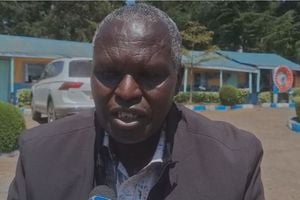How Kenya can avoid catastrophic climate change

A girl wearing the Kenyan flag wanders in the bush in Illeret, Marsabit County. Thousands of learners in northern Kenya were reported to have dropped out of school during the recent drought that plagued the country.
What you need to know:
- Africa is the most vulnerable region in the world to climate change impacts, a situation made worse by the continent’s lack of the financial muscle necessary to adequately build resilience to the climatic shocks.
“Science is clear. Drought, heatwaves and floods are our new reality,” says Patricia Nying’uro, a climate scientist with the Kenya Meteorological Department.
Her voice is firm as an attentive audience hangs onto her words. The scientist is presenting a report on the impacts of climate change in Kenya and how they have affected the lives and livelihoods of Kenyans over the years.
Patricia, who also serves as Kenya’s point person in the Intergovernmental Panel on Climate Change, a body that brings together climate scientists from around the world, says: “There is a lot of evidence that climate change is happening. In fact, our study has found that in East Africa, the average temperature has increased by between 0.7°C and 1°C, depending on the season.
The study— Climate Change Impacts in Kenya: What Climate Change Means for a Country and its People– was unveiled recently in Nairobi at a ceremony that brought together various players in the climate sector. It is just a 34-page document, but its contents are alarming. It says, for instance, that “heatwaves have become more severe and longer lasting in recent years, with Tana River, Garissa and Turkana counties being the most affected.”
The warming
So, what does this mean for the people living in those counties? Climate Action asks her.
“Well, like with many African countries, the warming over Kenya is very high. Africa’s warming is higher than the average – higher than many other continents. Actually, some studies we have done in the State of the Climate report of 2020 show that on average, we have areas that have warmed up 2.1°C, especially towards the coastal region. Several counties such as the three mentioned in the report are already above 1.5°C, surpassing the target that the world set in Paris in 2015,” she explains.
At least 70 per cent of Kenya’s economy is dependent on climate-sensitive sectors, and with such high temperatures, many are struggling, particularly agriculture. Studies have previously cited tea as one of the crops suffering from the effects of climate change, recording yield losses of between 14 and 20 per cent with every drought.
During the drought seasons, farmers often record plant mortality of up to 19 per cent. In 2020, five Kenyan scientists published a study titled Combating Climate Change in the Kenyan Tea Industry in the Frontiers journal documenting how climate change is affecting tea farmers.
“With climate change, it is expected that the main tea growing areas will experience an increase in the length of dry seasons per year, warmer temperatures, and/or extreme rainfall intensity. Climate data collected at the Kenya Agricultural Livestock Research Organisation –Tea Research Institute for 58 years indicate an annual temperature rise of 0.016°C per year while annual rainfall decreased by 4.82 mm per year over the same period. This has led to continued increase in soil water deficit over time,” the study says.
“Minimum air temperature required to support shoot growth is about 13–14°C, with optimum range of 18–30°C. Excessive daytime maximum temperature beyond 30°C is known to restrict shoot growth rate,” it adds.
As climate impacts in Kenya increase, ecosystems get harmed, affecting services such waster provision, air quality and carbon sequestration. The Patricia-led report reveals that the richness of species along the Tana River basin, which is an economically important and ecologically diverse region, is projected to reduce significantly with just 2°C of global temperature rise.
Plants and birds will be the most affected, and the impacts are projected to worsen with further warming. If the temperatures hit 1.5°C, at least 82 per cent of the biodiversity in the basin is projected to survive, a figure that will drop to 23 per cent with 2°C warming and drop further to three per cent if global temperatures rise to 40C.
“Today, the world is at 1.3°C warming against the 1.5°C set at COP21 in Paris in 2015, compared to when we had not started industrialising, in 1850,” Dr Joyce Kimutai, a climate scientist at the Kenya Meteorological Department who co-authored the climate study with Patricia, says.
“We normally use 1850 because it is from around 1870 going into 1900 that we started industrialising as a planet; and it was not a bad thing because we were trying to mechanise, particularly during the agricultural revolution. But over time, we have realised that all these activities we have been engaging in have actually been emitting a lot of greenhouse gases that cause the warming of the planet. The gases sort of form a blanket that traps heat, warming the planet. Now our planet is 1.3°C warmer. That has caused extreme events, which are increasing in terms of frequencies and magnitudes. We are seeing floods, droughts and heat waves, which are results of a warming planet,” she explains.
But although Kenya is highly vulnerable to extremities, particularly drought, scientists say studies differ as to whether droughts have been increasing or decreasing overall, but what they know for sure is that climate change has made the droughts experienced in the country since 2020 not only more severe, but also 100 times more likely.
Scientific data
In the same breath, there is limited scientific data on how heavy rainfall patterns have changed since 1950. But just like with drought, climate change increased the intensity of rainfall in the Horn of Africa in 2023, resulting in severe flash flooding in eastern Kenya. The floods led to deaths of at least 300 people and displaced more than a million others.
So, can Kenya avoid a climate disaster?
“Yes!” says Patricia, her eyes lighting up as if she has been expecting me to ask this question. “But like we always say, and even in the report we have done, we need immediate action. It’s really difficult for us to work in isolation, which is why the climate conversation is usually held globally. For Kenya, the action we can take is to ensure that we safeguard the lives and livelihoods of Kenyans. For example, we have documentation showing the impacts of climate change that we face.
“We have highlighted heatwaves, droughts and floods, which lead to other impacts such as mudslides, landslides and health issues. And because we have a clear picture of the current and future impacts, the most important thing we can do to avoid disaster is to plan. But I always say that as a priority, adaptation is what we should embrace as a country in order to avoid a major disaster,” she says.
Africa is the most vulnerable region in the world to climate change impacts, a situation made worse by the continent’s lack of the financial muscle necessary to adequately build resilience to the climatic shocks.
But as conversations on how to avoid a climate disaster grow louder, energy transition is seen as a key component. Joab Okanda, an energy consultant, says Kenya is already on track to a complete energy transition since more than 90 per cent of the grid is powered by renewable energy.
But can the world really survive on renewables alone?
“Actually, renewables are the silver bullet to the climate crisis. Energy, in terms of how it is produced, is a key driver of climate change and it has led us to where are now. So, the solution is to go back to the basics and use naturally available resources such as wind and solar to generate the energy we need.
“It requires a complete shift of how we think and how we operate the world around us, including the built environment. But to do that and solve the climate problem, we have to completely move away from fossil fuels,” he says.
But some parties argue that as much as energy transition is necessary, it is easier said than done. Various attempts have been made at the global level to get nations to commit to a fossil fuel phase-out, but they are yet to succeed.
“It would be easy to say we need to phase out fossil fuels because it’s what people want. That is an ideal ask, but unfortunately the world does not operate that way. For example, the Saudis, Indians and the Chinese will say phasing out fossil fuels means that economies will shut down. And that is still the case even for the developed world. We have been using the term 1.5°C but I think we have not been doing it in the pace that goes with the commitments under the Paris Agreement,” Dr Kimutai says.
Kenya says it needs an average of 63 billion dollars each year in order to adapt to and mitigate the impacts of climate change, but it can only finance about 13 per cent of that need. Organisations such as the World Bank have stepped in to fund adaptation projects through a programme known as Financing Locally Led Adaptation. The programme, which aims at scaling down climate action to the community level, currently runs in 46 counties.
Scientists believe that adaptation is what Africa needs more than mitigation because it is already living with the severe impacts of climate change, and it is therefore important to build the capacity of communities to survive those impacts. Adaptation measures include planting drought-tolerant crops, improving water storage and use, managing land to reduce wildfire risks, practising agroforestry and putting up resilient buildings and stronger defences against extreme weather like floods.
“Mitigation looks at things like; how do we reduce or slow down climate change? How do we reduce the greenhouse gasses that are being emitted? This includes actions like planting trees, optimising our transport and moving towards renewable energy. But adaptation is urgent because we have already seen the impacts of climate change. From 2020 to 2022, Kenya experienced drought. Shortly thereafter, we had devastating floods.
“We are already experiencing the impacts of climate change. How do we help communities? How do we help the country to cope with this? That is where adaptation comes in,” Patricia says.
Looking to the future, science shows that intense rainfall is expected to increase in most regions of Africa, and that children who were born in 2020 onwards are likely to be exposed to five times more heatwaves in their lifetime compared to people born in the 1960s– and this is even if the world succeeds in limiting global warming to 1.5°C. But if the temperature surpasses this target, as it is projected to do in the 2030s, the same 2020 children will be exposed to nine times more heatwaves in their lifetime under a 2.4°C warming.
Globally, 2024 is already set to be the hottest year on record, with record-breaking heat reported in June and July. July 23, 2024 was said to be the hottest ever, with an average of 17.06°C ((62.76 degrees Fahrenheit), the highest since 1940. In Africa, the highest temperatures were recorded in Morocco and Algeria when they both posted 50.4°C. International Labour Organisation reports that at least 70 per cent of the global workforce is exposed to extreme heat, resulting in 22 million injuries and 18,970 deaths each year. This situation has prompted the United Nation’s Secretary General Antonio Guterres to call on global leaders to “limit temperature rise to 1.5°C by phasing out fossil fuels and scaling up investment in renewable energy.”
And so to avoid a climate disaster, scientists say the only way out is to adapt.
Catch the premiere episode of Earthwise season 2 on Sunday for more on this story, only on NTV, at 8.25pm






